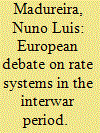| Srl | Item |
| 1 |
ID:
097495


|
|
|
|
|
| Publication |
2010.
|
| Summary/Abstract |
This article describes a particular branch that evolved in the diffusion of electrical rate systems in twentieth-century Europe and the debate that ensued between the competitive, promotional and cost based approaches. Three major questions are addressed: What factors and historical circumstances favoured the emergence of more or less efficient pricing schemes? Why did some enterprises opt for promotional rates while others defended the cost based alternative? What is the historical origin of marginal cost pricing? It is shown how the volatility of the costs that characterize hydro-electric production made this particular technology very sensitive to a cost approach towards pricing and to a seasonal and time-of-day perspective on rate systems.
|
|
|
|
|
|
|
|
|
|
|
|
|
|
|
|
| 2 |
ID:
177104


|
|
|
|
|
| Summary/Abstract |
Price deregulation in Australia's National Electricity Market has led to increased competition and greater price dispersion in retail electricity markets. However, recent increases in electricity prices and concerns around disengaged customers have led policy makers to impose a ‘default offer’ to cap retail electricity prices. In this article, we develop a model that demonstrates the mechanism through which a price cap leads to the withdrawal of the lowest priced offers from the market, in effect reducing the benefits available to customers that ‘shop around’. We calculate a measure of actual price dispersion showing that a compression of offers since the price cap was imposed has reduced the returns from search by 2.3 per cent, or $37 per year on average. We argue that the important issue of vulnerable, disengaged customers on high priced offers is best addressed through non-price regulation policy options, such as an auction for the right to serve customers that are both vulnerable and disengaged.
|
|
|
|
|
|
|
|
|
|
|
|
|
|
|
|
| 3 |
ID:
125471


|
|
|
|
|
| Publication |
2013.
|
| Summary/Abstract |
Successful real-time electricity pricing depends firstly upon consumers' willingness to subscribe to such terms and, secondly, on their ability to curb consumption levels. The present paper addresses both issues by considering consumers differentiated by their electricity saving costs, half of whom resist saving electricity. We demonstrate that when consumers are free to adopt real-time prices, producers prefer charging inefficient prices and, in so doing, discriminate against that portion of the consumer population which faces no saving costs. We also find that efficient marginal cost pricing is feasible, but is incompatible with mass adoption of real-time prices.
|
|
|
|
|
|
|
|
|
|
|
|
|
|
|
|
| 4 |
ID:
130543


|
|
|
|
|
| Publication |
2014.
|
| Summary/Abstract |
This paper examines whether a casino tax is good for local welfare in a tourism economy. We find that what is important for efficiency is not the tax rate itself but the tax incidence on tourists. Casino tourism in Macao engages in price discrimination via market segmentation. We prove that, compared with the mass market, the VIP market will grow faster with a greater price rise if a tax hike on the VIP market is not large, but will grow less rapidly with a smaller price increase if the tax hike is very large. An empirical study is carried out using data from Macao, which is typical of segmenting markets for discriminatory pricing. We show that our theory is largely consistent with observed evidence. This paper also provides some policy recommendations useful for Macao. We propose that its casino tax should be kept low at its current rate in the mass market but be raised substantially in the VIP market if its economic growth is to be made less unbalanced and more sustainable.
|
|
|
|
|
|
|
|
|
|
|
|
|
|
|
|